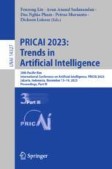Search
Search Results
-
Using Knowledge Graphs to Improve Question Difficulty Estimation from Text
Question Difficulty Estimation (QDE) is a crucial task in many educational settings. Previous research focused on Natural Language Processing (NLP)...
-
Design and energy dissipation analysis of simple QCA multiplexer for nanocomputing
The multiplexer is an integral design component of the conventional CMOS technology and modern QCA nanotechnology. It is also an elementary building...

-
Question difficulty estimation via enhanced directional modality association transformer
Estimating the difficulty of a question in video QAs is one of the important reasoning steps to answer the question. However, no previous question...

-
AI-Based Intelligent-Annotation Algorithm for Medical Segmentation from Ultrasound Data
The management of prostate cancer, a prevalent source of mortality in men, calls for meticulous delineation of the prostate in transrectal ultrasound...
-
Optimized activation for quantum-inspired self-supervised neural network based fully automated brain lesion segmentation
Due to the lack of appropriate tailoring of the inter-connection weights, the segmentation performance of the recently suggested Quantum-inspired...

-
Optimal demultiplexer unit design and energy estimation using quantum dot cellular automata
Quantum dot cellular automata (QCA)-based demultiplexer or DeMUX is a basic module of nanocommunication and nanocomputation, like a multiplexer....

-
Develo** a Projection Approach to DSL Development
This chapter proposes the author’s solution to the problem posed in Chap. 2 of develo** a generalized...
-
An ultra-area-efficient ALU design in QCA technology using synchronized clock zone scheme
A quantum-dot cellular automaton (QCA) is currently regarded as a radical nanotechnology that is rapidly growing and offering new methods for...

-
High performance nanocomparator: a quantum dot cellular automata-based approach
Quantum dot cellular automata (QCA) are emerging nanotechnology that offers few significant advantages like faster speed, higher circuit density, and...

-
Model-Driven Intelligent Decision Support Systems
In this chapter, the main kind of Model-driven methods that can be used in Intelligent Decision Support Systems are described: Agent-based Simulation...
-
An ultra-dense and cost-efficient coplanar RAM cell design in quantum-dot cellular automata technology
The quantum-dot cellular automata (QCA) are an alternative nanotechnology for overcoming the drawbacks of traditional CMOS technology. QCA is one of...

-
Qualitative reasoning and cyber-physical systems: abstraction, modeling, and optimized simulation
Complex systems modeling and simulation are critical in many industrial and research fields, specifically to predict, prove, verify, and understand...

-
Optimizing 3D Object Detection with Data Importance-Based Loss Reweighting
With the advancement of AI technology, deep learning-based intelligent driving assistance systems have seen substantial growth. However, 3D object...
-
Scalable feature subset selection for big data using parallel hybrid evolutionary algorithm based wrapper under apache spark environment
Extant sequential wrapper-based feature subset selection (FSS) algorithms are not scalable and yield poor performance when applied to big datasets....

-
Pelican optimization algorithm with convolutional-recurrent hop field neural network for unmanned aerial image classification model
Nowadays, unmanned aerial vehicles (UAVs) becomes more prominent because of their benefits namely versatile, inexpensive, scalable, and autonomous....

-
Transferring a Learned Qualitative Cart-Pole Control Model to Uneven Terrains
Qualitative modeling can be applied to the control of dynamic systems by following these steps: (1) learning a qualitative model of the controlled...
-
Lagrange Stability of BAM Quaternion-Valued Inertial Neural Networks via Auxiliary Function-Based Integral Inequalities
This article is concerned with the global exponential stability in Lagrange sense of bidirectional associative memory quaternion-valued inertial...

-
An overview of deep learning techniques for COVID-19 detection: methods, challenges, and future works
The World Health Organization (WHO) declared a pandemic in response to the coronavirus COVID-19 in 2020, which resulted in numerous deaths worldwide....

-
OBRUN algorithm for the capacity-constrained joint replenishment and delivery problem with trade credits
This study investigates the joint replenishment and delivery problem taking trade credits the delay in payment permitted by suppliers and...

-
Population-scale identification of differential adverse events before and during a pandemic
Adverse patient safety events, unintended injuries resulting from medical therapy, were associated with 110,000 deaths in the United States in 2019....

